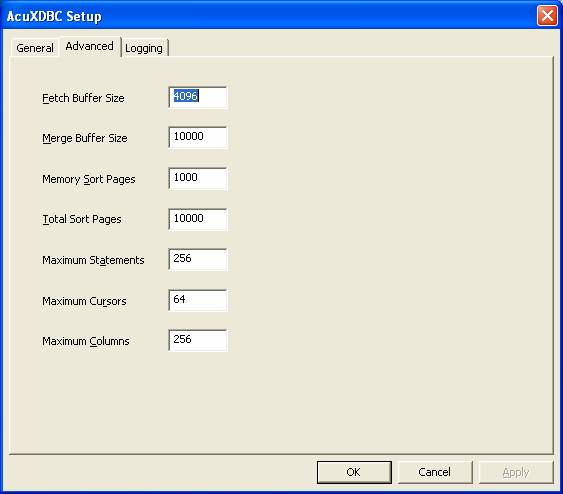AcuXDBC Setup: Advanced Tab
Into the Advanced tab, enter the following infromation or accept the defaults, then click OK.

| Field | Description |
|---|---|
|
Fetch Buffer Size |
Enter the size of the fetch buffer in bytes. The fetch buffer indicates how much data will be fetched or retrieved from a query at time. Allowable values are 1024 through 32766. Default value is 4096. |
|
Merge Buffer Size |
Enter the size of the merge buffer in rows. This is the number of unique rows that your query can return. Default value is 10,000. |
|
Memory Sort Pages |
Enter the number of memory sort pages. This indicates how many of the "Total Sort Pages" will reside in memory. Allowed values are 100 to 999,999. Default value is 1000. |
|
Total Sort Pages |
Enter the total number of sort pages. Total sort pages is the number of virtual memory pages used to sort results sets. Allowed values are 1000 to 99,999,999. Default value is 10,000. |
|
Maximum Statements |
Enter the maximum number of statements allowed. Values are 10 to 4096. Default value is 256. See Maximum Cursors. |
|
Maximum Cursors |
Enter the maximum number of cursors allowed. Allowable values are 10 to 1024. Default value is 64. AcuXDBC has a concept of logical cursors (nlc) that are mapped over a smaller number of actual DB Cursors (ndc). If you create SQL statements equal to or fewer than the number of DB Cursors set, it is a straight one-to-one relationship. However, when you attempt to open more, AcuXDBC searches for the oldest "soft-closed" logical cursor that it can "unhook" from a data base cursor and assign to the new statement. If the application tries to use the original statement, AcuXDBC will look for another unused logical cursor to donate its DB Cursor. If no cursors can be unhooked (because results are pending), then an error message "Too many concurrently open cursors" is returned. |
|
Maximum Columns |
Enter the maximum number of columns allowed in a single table. Allowable is 1 to 1024. Default value is 256. (Please not that
some Microsoft applications will not allow more thank 256 columns in a table.)
Note: The Vision file or table supports 65535 field names (columns); however, you may be limited in your queries to the table based
on the query tool used. For instance, the command-line query tool will support only result sets with a maximum number of 512
columns. Queries through ODBC Driver default to 1024 columns.
|